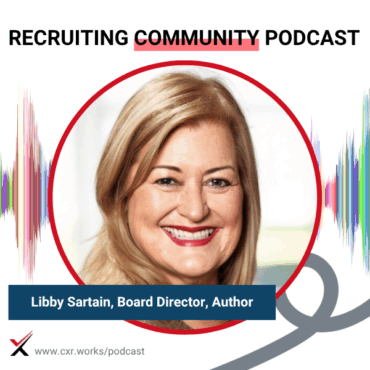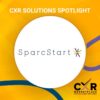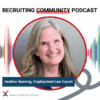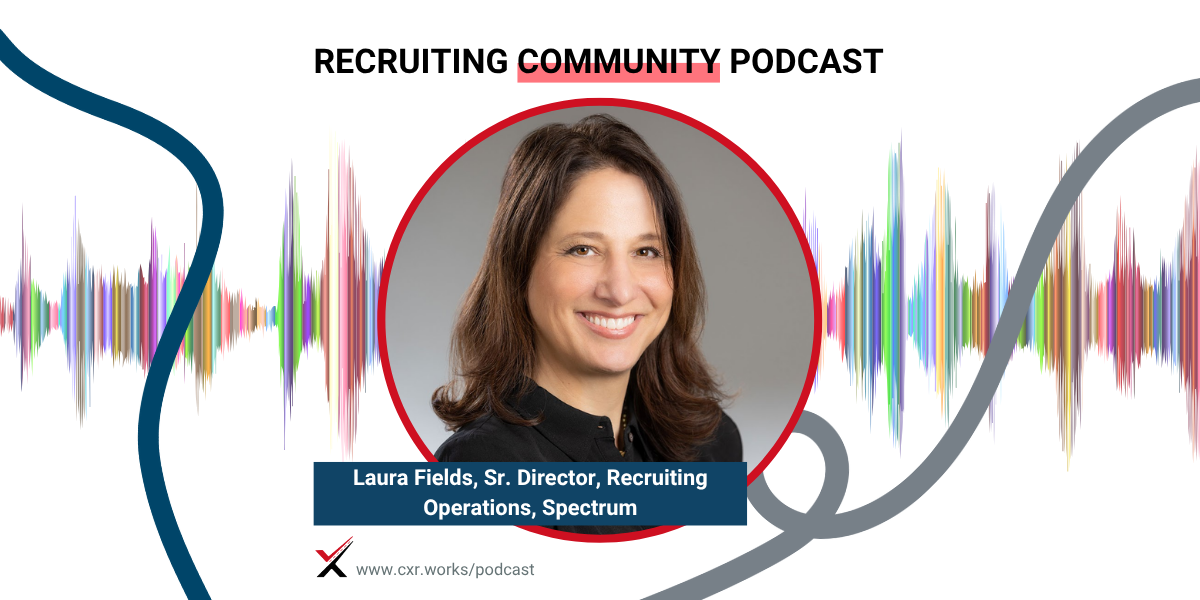
Giving Back with Libby Sartain
What happens after the CHRO chapter ends? Libby Sartain shares how she built a legacy of leadership, board service, and meaningful community impact.
 play_arrow
play_arrow
Solutions Spotlight on SparcStart Cami Grace
 play_arrow
play_arrow
From Operations to Coaching: Lori Chartrand’s Career Crossroads Cami Grace
 play_arrow
play_arrow
Beyond ‘Don’t Do X’: Compliance as Problem-Solving Cami Grace
 play_arrow
play_arrow
Career Crossroads: A New Series from the CXR Team Cami Grace

Title:
Using AI to Make Recruiting More Human-Centric
Featured Guests:
Laura Fields, Director of TA Operations, Spectrum
Hosts:
Chris Hoyt, President, CareerXroads
Gerry Crispin, Principal and Co-founder, CareerXroads
Episode Overview:
Spectrum’s Laura Fields joins the CXR podcast to share how her team is using AI to improve efficiency and transparency in talent acquisition. With a background in industrial-organizational psychology, Fields offers practical insights on evaluating AI tools, piloting them within the hiring funnel, and maintaining human oversight. She highlights what’s working, what’s overhyped, and where employers need to remain cautious.
Key Topics:
Real-world use of AI for candidate scheduling and screening
Piloting AI assessments in high-volume, early-stage hiring
Building trust with hiring managers through transparency
How to evaluate vendors and spot red flags in AI offerings
The importance of internal expertise in AI and selection science
Current regulatory fragmentation and the need for standards
Use cases for generative AI that improve recruiter experience
Notable Quotes:
“We’re dipping our toe in—not doing a full cannonball into AI-driven decisions.” — Laura Fields
“I want to see IO psychologists on the vendor’s team—not just economists.” — Laura Fields
“AI should be an assistant, not an authority.” — Laura Fields
“Don’t wait for perfect answers. Start asking better questions now.” — Gerry Crispin
“If an algorithm evolves, I want to know how—and whether I can trust it.” — Laura Fields
Takeaways:
AI can improve early-funnel efficiency and recruiter workload, but only when paired with scientific oversight and transparency. Spectrum’s approach to vetting vendors, piloting tools, and retaining human-in-the-loop decision-making offers a blueprint for responsible AI integration in TA. As regulatory standards remain unclear, internal expertise and proactive evaluation are more essential than ever.
Want more conversations like this?
Subscribe to the CXR podcast and explore how top talent leaders are shaping the future of recruiting. Learn more about the CareerXroads community at cxr.works.
Chris Hoyt: Just a full disclaimer—we are live, and we’ve got a little bit of a lag issue happening on my end. I may be the worst host today ever. But Gerry will be happy to drive if this goes off the rails.
Gerry, you just jumped from one event to the next. You were on another panel just before this, right?
Gerry Crispin: Yeah, this is remote from a hotel. I found an empty ballroom and decided to take it over. Someone opened the door, saw me in here, and closed it. I’m not sure what that meant, but we’re good.
This week, our friend Michael Marlatt put together an event on AI. It spans two days and brings together a broad spectrum of folks who have something to say about the topic. Keith Sonderling from the EEOC will be on tomorrow morning. Kevin Wheeler did a great keynote kickoff to set the stage.
He focused on how fast AI is coming at us and how much we, as professionals, need to upskill on the issues that may change our roles and jobs.
Chris Hoyt: And Laura, we’re excited to have you on because you’re talking about implementing AI in what many are calling a practical way—something useful in the TA workflow or decision-making.
Do you have any sort of intake form at Spectrum that challenges AI vendors on their claims?
Laura Fields: Great question. No, we don’t have a standard form—at least not right now. Most of the AI we’ve adopted came after we already had the vendor, so we’ve been able to just talk directly with them about their AI offerings.
Gerry Crispin: Makes sense. I will say there’s a flaw here: while we’re pretty much in agreement about what questions to ask vendors, we’re not in agreement on what a good answer looks like. That will evolve over time. It really depends on the context of how AI is being used—and that means constant learning.
Chris Hoyt: All right. We’ve got about 15-20 minutes, so let’s jump in. Here we go.
Announcer: Welcome to the CXR channel, our premier podcast for talent acquisition and talent management. Listen in as the CXR community discusses a wide range of topics focused on attracting, engaging, and retaining the best talent. We’re glad you’re here.
Chris Hoyt: Welcome everybody to the Recruiting Community Podcast. We do a weekly livestream on YouTube, Facebook, and LinkedIn. If you’re joining us live on LinkedIn, jump into the chat and say hi. You can ask questions of our guest too.
You can find all 400 previous episodes at cxr.works/podcast. Quick reminder: this is an ad-free labor of love that Gerry and I do because we think our guests have something interesting to say.
I’m your host, Wayne, and I’m joined by my co-host Garth. How are you doing, Garth?
Gerry Crispin: One of these days you’re going to have to tell me ahead of time who I’m going to be so I can get the hat that fits. I didn’t know there would be costumes.
Chris Hoyt: Let’s welcome Laura Fields from Spectrum. Hi Laura—welcome back!
Laura Fields: Thanks! Happy to be here.
Chris Hoyt: For those who don’t know you, can you give us a quick pitch? Who’s Laura Fields, and why should folks listen to what you have to say about AI and TA?
Laura Fields: Sure! I’m currently based in Charlotte, NC at Spectrum’s headquarters. I oversee TA operations as well as selection and assessment. My educational background is in IO psychology, and I’ve been working in selection since—well, let’s just say a year that starts with “19.”
Traditionally, that’s meant interviews and assessments, but now I’m adapting that knowledge to the world of AI.
Chris Hoyt: Love it. We’re so glad you’re here. Can you share how Spectrum is integrating AI into recruiting operations? Where in the hiring funnel have you seen the most improvement?
Laura Fields: Great question. First, a quick note: what we’re using now is automated decision-making AI, not generative AI.
The biggest lift we’ve seen is early in the funnel. Five years ago, we adopted candidate self-scheduling tools that use AI to integrate with calendars—that was a huge time-saver for recruiters.
Now, we’re trying to do the same thing with early-stage screening. Whether that’s AI in assessments or resume review, that’s where we’re seeing the most impact. The more data you have, the more AI can help you.
Chris Hoyt: So was there any challenge you encountered when implementing that?
Laura Fields: Definitely. For example, we use AI scoring in our virtual job tryout assessments for chat agents. The AI reads candidate responses and scores them just like a human would. The challenge was getting hiring managers comfortable with AI making those evaluations.
To overcome that, I focused on transparency—showing them side-by-side comparisons of how humans versus AI scored the same responses. Once they saw that, they were on board.
Chris Hoyt: So you picked a specific function and piloted it?
Laura Fields: Exactly. We started with chat agents—a brand new function with high applicant volume. Recruiters didn’t want the extra scoring work, and managers didn’t want to risk poor hiring decisions. Transparency and shared interests helped us clear those hurdles.
Gerry Crispin: You bring up a key point: having someone like you—with a background in selection science—is critical. You can evaluate vendors and tools properly and understand the implications.
Laura Fields: 100%. Whether you hire a consultant or build an internal team, that expertise is necessary.
Gerry Crispin: With generative AI, it raises everything to a new level. If an algorithm evolves based on candidate responses, we’ll want to know how—and whether we can trust it. We need visibility into what it’s learning and when.
Laura Fields: Exactly. I don’t want AI that changes how it makes decisions mid-requisition. I want to see how it’s learning and ensure there’s no adverse impact. That’s where transparency is everything.
Gerry Crispin: And you’re smart to ensure AI is currently making recommendations, not decisions. That mitigates risk.
Laura Fields: Right. We’re dipping our toe in, not doing a full cannonball into AI-driven decisions.
Chris Hoyt: Love that analogy—sending a kid into the kitchen to make a sandwich for the first time!
Laura, when selecting vendors now, what criteria do you prioritize?
Laura Fields: First, I check their leadership. If it’s all economists and data scientists, I’m cautious. I want to see IO psychologists or people with behavioral science backgrounds on the team.
Second, I ask about ethics. Most vendors claim to be “ethical,” but when you ask detailed questions—like how scores are generated and whether they change over time—you’ll see who’s legit.
I also want to know how I can audit the AI. Can I run a manual comparison? What’s the transparency like?
Chris Hoyt: That’s a great segue. We’ve worked with 20 vendors and several corporate leaders to build an open-source RFI/RFP template that you can use to vet AI vendors. Gerry, want to talk briefly about that?
Gerry Crispin: Sure. This is a living document with 22 questions employers can use when evaluating vendors. It’s designed to plug into your RFI or RFP process. The key is it helps employers ask the right questions—even though we may not yet know what the right answers are. That will evolve over time.
Chris Hoyt: If you want to grab it, it’s at cxr.works/ai-rfip. That’s “AI-RFIP”—we’re calling it “Air-Fip.”
Laura, would you agree that it’s going to be at least two years before we reach any kind of standard?
Laura Fields: At least. IO psychologists are still using standards from 1978! The field moves slowly. Right now, states are driving the regulations, and each one is doing it differently.
Gerry Crispin: And don’t forget, other countries are in the mix too.
Chris Hoyt: So let’s flip it. What generative AI solutions should vendors focus on—and which ones are overhyped?
Laura Fields: Overhyped? Writing job descriptions. That’s table stakes now.
Vendors should focus on improving candidate and recruiter experience. For example: let the AI help recruiters identify next best actions in the ATS or generate personalized candidate communications. But stay away from selection. Don’t try to prioritize resumes or generate interview questions. That’s risky and can create consistency issues.
Chris Hoyt: So use AI as an assistant—not an authority. And we’ve seen some crazy stuff come out of generative tools. No thanks!
Laura Fields: Exactly. You have to get your hands dirty with this stuff to really understand what it’s doing.
Chris Hoyt: Laura, you’ve been a wonderful guest. Let’s wrap with our favorite question: if you were writing a book about the state of AI in TA today, what would the title be?
Laura Fields: Alice’s Adventures in AI Wonderland.
Chris Hoyt: Love it. And who gets the first signed copy?
Laura Fields: Jen Tracy—for sponsoring all my wild, mushroom-fueled AI adventures!
Chris Hoyt: Perfect. Laura, thank you again so much. We really appreciate your time and insights.
For everybody else, we’ll see you next week. You can find us at cxr.works/podcast.
Announcer: Thanks for listening to the CXR channel. Please subscribe to CXR on your favorite podcast resource and leave us a review while you’re at it. Learn more at cxr.works, facebook.com/careercrossroads, and on Instagram at CareerXroads. We’ll catch you next time.
Tagged as: Talent Acquisition, Spectrum, Laura Fields, Recruiting, AI assessments, AI, selection science, Podcast, vendor evaluation, Human, Centric, Artificial Intelligence, Candidate Experience.
Chris Hoyt is the President of CareerXroads, a global peer community for talent acquisition leaders driving strategic change. With decades of experience leading recruiting innovation at Fortune 500 companies, Chris now advises enterprise TA teams on tech, process, and leadership. He’s a frequent speaker at conferences like SHRM, HR Tech, LinkedIn, and UNLEASH, and he’s known for pushing conversations beyond buzzwords to get to what really works in hiring. Through CXR, he connects top TA professionals to solve real problems, challenge norms, and shape the future of recruiting.

What happens after the CHRO chapter ends? Libby Sartain shares how she built a legacy of leadership, board service, and meaningful community impact.

